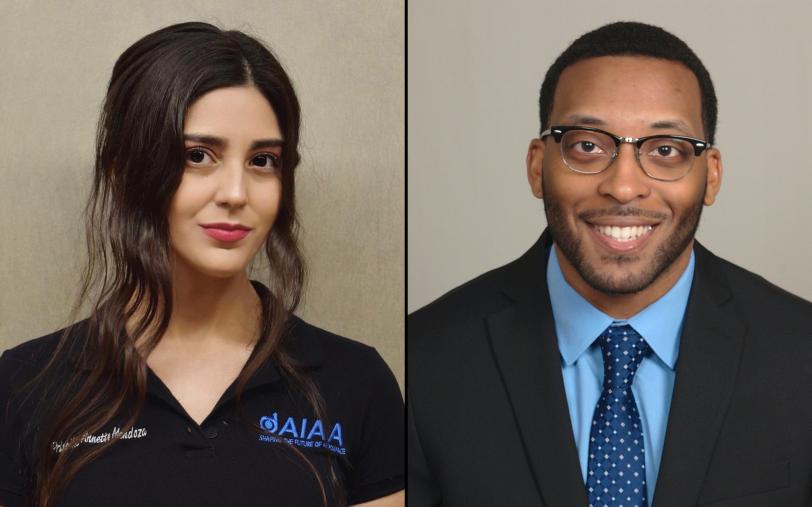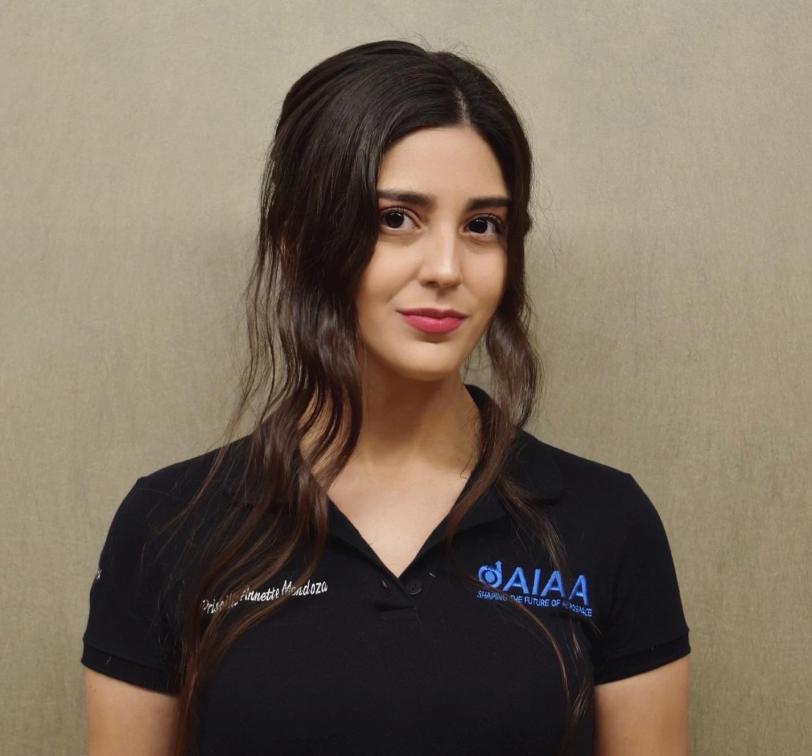GEM Fellows' courage leads them on paths of self-discovery
Two determined fellows share their thoughts on representation, mentorship and staying true to themselves in STEM.
By Michael Hahn

For Annette Mendoza and Damion Tingle, it’s a lesson that’s been years in the making: Believe in yourself and trust the people who believe in you.
Last summer, Mendoza and Tingle were able to apply that lesson to their pursuit of hands-on STEM career experience through the National GEM Consortium, an organization that coordinates internships and provides funding for graduate studies for underrepresented students in science, technology, engineering and math.
Mendoza and Tingle spent their summers as GEM Fellows at the Department of Energy’s SLAC National Accelerator Laboratory. Here, Mendoza studied the properties of perovskites, which have shown promise in solar energy applications, while Tingle studied anomalies in dark matter detectors. Mendoza is now an engineer in sustainable energy, and Tingle is completing a master’s degree in physics at North Carolina Agricultural & Technical (A&T) State University.
The fellows said the program and research experience strengthened their feelings of belonging in STEM.
“I felt empowered to look inward and value my own contributions,” Mendoza said. For Tingle the program gave him a place where he "could show up as my authentic self.”
SLAC scientist and mentor Arianna Gleason echoed their comments, adding “the GEM Fellows enriched the experience for everyone through their commitment to personal growth. It was exciting and inspiring to keep the activities moving forward,” she continued, “and make progress on the science while demonstrating an aspirational culture at SLAC.”
SLAC scientist and mentor Maria Elena Monzani said the experience was outstanding for her as well. “I loved serving as a mentor," she said. "The GEM Fellows’ authenticity was a breath of fresh air. Their enthusiasm for learning allowed them to rapidly build an impressive skill set during their mentorships.”
Since the beginning of SLAC’s partnership with GEM in the 1970s, the lab has supported more than 50 fellows as they pursue STEM education and careers. The application cycle for the next round of GEM fellowships opens on July 1.

Standing her ground
Mendoza's interest in science started at Montwood High School in El Paso, Texas, where she was drawn to learn how things work at a fundamental level. “I loved learning about topics related to motion, like kinetics and energy,” she said. A few of her science teachers picked up on that too, so they suggested she apply her interest in science to her love of problem-solving.
“I needed that nudge from my teachers,” Mendoza said, who credits them for helping her realize that she wanted to be an engineer.
In college at the University of Texas, El Paso (UTEP), Mendoza turned her focus to mechanical engineering. While there, her course of study got strenuous. Topics like thermodynamics and the mechanics of materials were difficult to grasp, she said, but Mendoza found inspiration in her professors, who encouraged her to prove to herself that she could prevail.
That’s just what she did, working hard to earn bachelor’s and master’s degrees in mechanical engineering. “You can’t get something from nothing. You need to put in the work,” she said.
At SLAC, Mendoza worked with staff scientist Arianna Gleason on the Matter in Extreme Conditions instrument at SLAC's Linac Coherent Light Source to examine perovskite-structured minerals, a type of material found in the Earth’s mantle that can be used to produce clean energy. Gleason's team puts those minerals under extreme pressures and temperatures, then bounces X-rays off them and measures the resulting changes in X-ray and optical laser scattering using an instrument called an interferometer, helping to reveal their properties.
“Dr. Gleason guided me through so much interesting material being worked on at SLAC, including the interferometer system that extracted the data we used in our project,” Mendoza said.
And Gleason set a valuable example. “She taught me to never doubt myself no matter how hard the work may be,” Mendoza said. As a woman in engineering, Mendoza said it’s a message she needed to hear.
“When uncertainty has caused me to question my abilities, I have learned to stand my ground and demonstrate my value,” Mendoza said.
Believing in himself
The youngest of three brothers, Tingle credits his two-minute-older twin for turning his interests toward STEM. The brothers would tinker with their bicycles, fixing and modifying them with little else than the courage to pick up the pieces and try again. Over time, that courage became motivation to walk his own path.
But during his high school years, science had taken a seat on the sidelines. “I got lucky because science and math clicked, but school wasn’t really my thing,” Tingle said. And what was his thing? “Sports. I just loved to play,” he said.
The turning point for Tingle came at Contra Costa Community College. In his coursework there, Tingle learned about the history of scientific contributions from around the world, including engineering achievements in African societies, which he said, “deepened my appreciation for science.” When he transferred to North Carolina A&T State University in Greensboro, Tingle chose physics as his major.
Topics like quantum mechanics and electromagnetism, which Tingle loves for their peculiar conclusions about the natural world, were demanding, so he learned to lean on his family and friends for support. “I questioned myself,” Tingle said, “but they believed in me.”
One day, SLAC’s Maria Elena Monzani happened to be giving a talk at North Carolina A&T and Tingle was in the audience. He’d already applied for a GEM fellowship in which he expressed interest in her research, so he introduced himself and crossed his fingers.
At SLAC, Tingle worked with Monzani on the LUX-ZEPLIN experiment, a dark matter detector located deep underground in the Black Hills of South Dakota. There, a detection system tracks particle collisions in a tank filled with liquid xenon as particles stream into the tank and collide and scatter off xenon atoms. Researchers use a machine learning algorithm to try to make sense of all those collisions, but the algorithm can make mistakes.
“The instrument’s machine learning algorithm would assume that all particle collisions resulted in actual scattering, but this wasn’t the case. To mitigate this issue, I rewrote the code that trains the machine learning algorithm to distinguish which collisions actually took place,” Tingle said.
In reflecting on his experience, Tingle said, “I could just be myself, that kid from high school who loves sports, and also be a scientist.”
And he has some words of encouragement: “Don’t let imposter syndrome defeat you. Trust the people who tell you that you belong because you do.”
For more information about GEM Fellowships and to apply, visit https://www.gemfellowship.org.
For questions or comments, contact the SLAC Office of Communications at communications@slac.stanford.edu.
About SLAC
SLAC National Accelerator Laboratory explores how the universe works at the biggest, smallest and fastest scales and invents powerful tools used by researchers around the globe. As world leaders in ultrafast science and bold explorers of the physics of the universe, we forge new ground in understanding our origins and building a healthier and more sustainable future. Our discovery and innovation help develop new materials and chemical processes and open unprecedented views of the cosmos and life’s most delicate machinery. Building on more than 60 years of visionary research, we help shape the future by advancing areas such as quantum technology, scientific computing and the development of next-generation accelerators.
SLAC is operated by Stanford University for the U.S. Department of Energy’s Office of Science. The Office of Science is the single largest supporter of basic research in the physical sciences in the United States and is working to address some of the most pressing challenges of our time.





